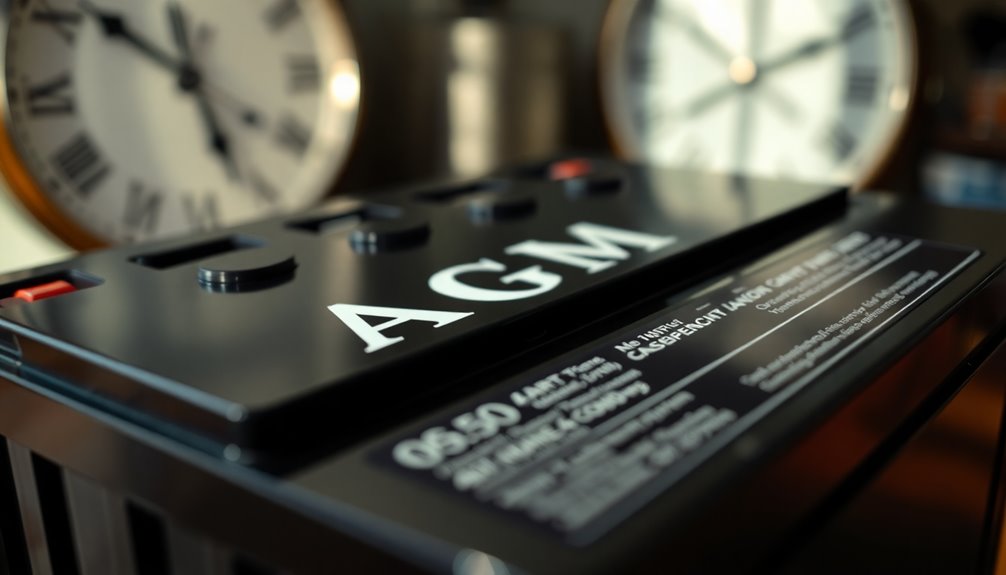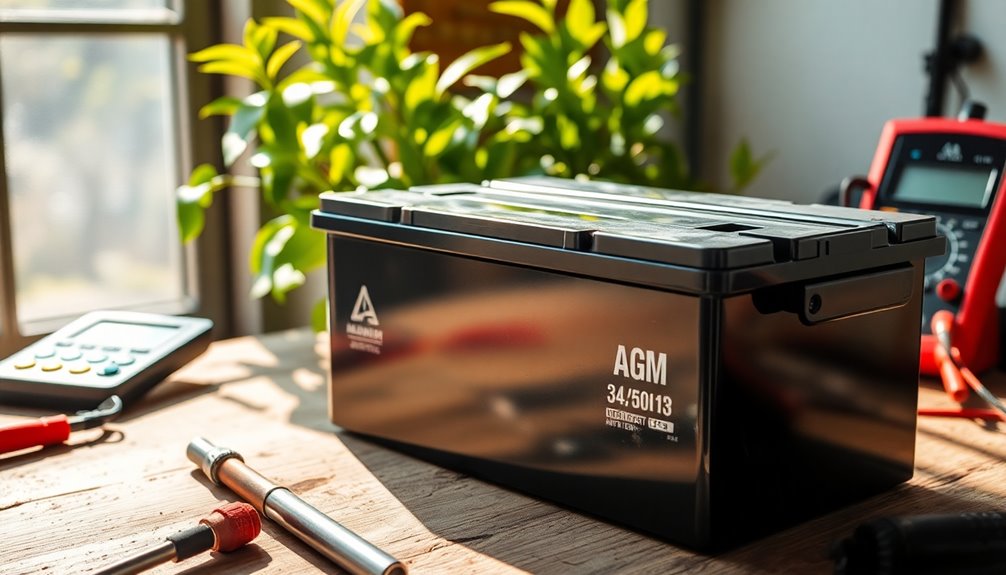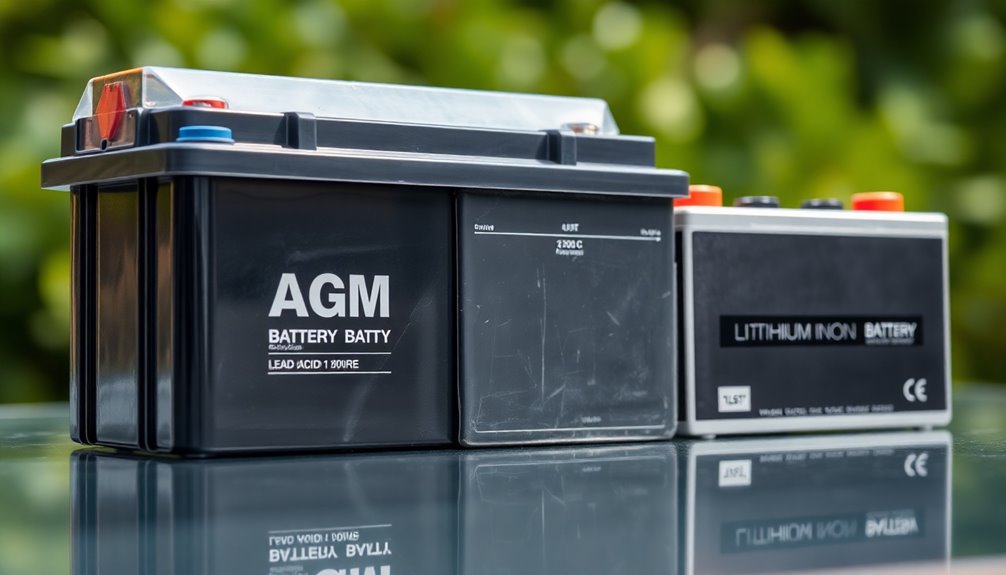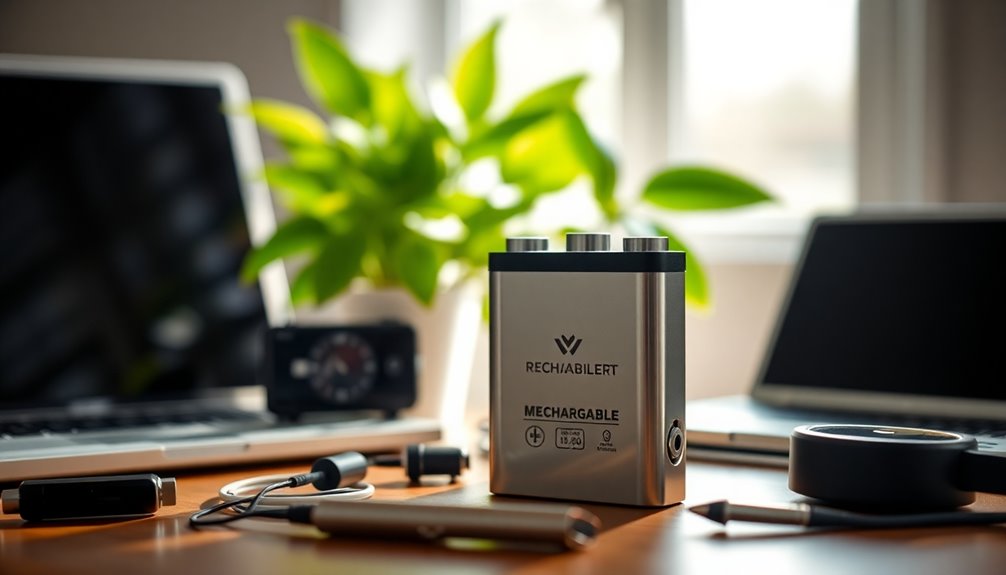AGM batteries typically last between 3 to 7 years, depending on how you use and maintain them. If you're engaging in deep cycling, expect a shorter lifespan of around 3 to 5 years. Temperatures play a significant role, too—keeping the battery under 77°F (25°C) helps enhance longevity. Regular maintenance, like avoiding deep discharges and using the right chargers, can further extend their life. So, if you want to guarantee your AGM battery lasts as long as possible, there are best practices you can follow and essential factors to take into account for peak performance and reliability.
Key Takeaways
- AGM batteries typically last between 3 to 7 years under standard conditions, with 3 to 5 years for deep cycling applications.
- AGM batteries retain about 80% capacity after 5-6 years, but lithium-ion batteries maintain higher efficiency over time.
- Factors like installation quality, operating temperature, and usage patterns significantly influence the longevity of AGM batteries.
- Proper maintenance, such as regular charging and inspections, can extend the lifespan of AGM batteries.
- AGM batteries are advantageous for rapid discharge and recharge cycles but have a shorter lifespan compared to lithium-ion options.
Understanding AGM Batteries

When you explore AGM batteries, you'll discover that they stand out due to their unique design and efficiency.
AGM, or Absorbed Glass Mat batteries, are a type of valve-regulated lead-acid battery where the electrolyte is absorbed into fiberglass mats. This design prevents leakage and allows for a maintenance-free battery experience.
Compared to traditional flooded lead-acid batteries, AGM batteries boast a higher energy density, delivering more power in a compact size. They also excel in rapid discharge and recharge cycles, making them perfect for applications like renewable energy systems and backup power.
Plus, their construction enhances safety by minimizing spill risks, allowing for installation in any orientation.
Lifespan of AGM Batteries

Understanding the lifespan of AGM batteries is essential for maximizing their efficiency and ensuring reliable performance. Typically, AGM batteries last between 3 to 7 years under standard conditions, with some even exceeding a decade in ideal situations.
To achieve long-term reliability, consider these key points:
- Lifespan can drop to 3 to 5 years in deep cycling applications, like solar storage.
- Maintaining operating temperatures below 77°F (25°C) is vital for longevity.
- Avoid deep discharges below 50% to protect battery health and performance.
- Utilize smart chargers specifically designed for AGM batteries to enhance lifespan.
Factors Influencing Battery Longevity

Several factors notably influence the longevity of AGM batteries, impacting how long they'll serve you effectively.
The design and installation of your AGM battery play an essential role; poor setups can lead to early failure. Operating temperature is another key player—keeping the battery below 77°F (25°C) is ideal, as high temperatures can accelerate degradation.
You should also be cautious with deep discharges; regularly going below a 50% state of charge can greatly reduce reliability. Additionally, your usage patterns, like the frequency of discharge cycles, significantly affect battery life.
Regular maintenance checks and proper charging practices can help you extend your AGM battery's lifespan beyond the typical 3 to 7 years. Take these factors into account to maximize your investment.
Best Practices for Longevity

To get the most out of your AGM batteries, proper charging techniques and regular maintenance checks are key.
Make sure you charge your batteries before they drop below 20% and monitor their voltage and temperature regularly.
Proper Charging Techniques
While you might be tempted to charge your AGM battery as soon as it dips below full capacity, adopting proper charging techniques can greatly impact its longevity.
Here are some best practices to enhance your battery's ability:
- Always discharge your AGM batteries to at least 20% before recharging to prevent deep discharges that can harm reliability.
- Avoid letting the charge drop below 50% and refrain from full cycle charging (0% to 100%).
- Use smart chargers specifically designed for AGM batteries to tailor the charging process and prevent overcharging.
- Store your batteries in a cool, dry environment to protect against extreme temperatures that can degrade performance.
Regular Maintenance Checks
Proper charging techniques set the stage for ideal AGM battery performance, but regular maintenance checks are equally important for longevity. You should regularly inspect AGM batteries for corrosion or swelling, as catching these issues early can prevent failure. Monitoring the battery's state of charge is vital; keep it above 50% to enhance lifespan. Additionally, routine load testing every 6 to 12 months evaluates performance under stress. Remember to keep terminals clean using a baking soda and water mixture to remove buildup. Following the manufacturer's guidelines and using smart chargers designed for AGM technology will maximize performance.
| Maintenance Task | Frequency |
|---|---|
| Inspect AGM batteries | Monthly |
| Clean terminals | Every 3 months |
| Monitor state of charge | Weekly |
| Routine load testing | Every 6-12 months |
| Follow manufacturer guidelines | Always |
Comparing AGM With Other Batteries

When you compare AGM batteries to lithium-ion options, you'll notice a significant difference in lifespan and performance.
While AGM batteries are cost-effective against traditional flooded batteries, they can't match the durability of lithium-ion or gel batteries under extreme conditions.
Let's explore how these various types stack up regarding longevity, cost, and reliability.
AGM vs. Lithium-Ion Lifespan
As you compare AGM batteries with lithium-ion options, it's clear that lifespan plays a crucial role in your decision-making. Here's what you need to know:
- Lifespan: AGM batteries last around 3 to 7 years, while lithium-ion batteries can exceed 2000 cycles.
- Capacity Retention: AGM batteries retain about 80% of their capacity after 5-6 years, whereas lithium-ion batteries maintain higher efficiency due to lower self-discharge rates.
- Deep Cycling: AGM batteries handle deep cycling but last only 3 to 5 years under heavy use compared to lithium-ion's extended performance.
- Memory Effect: Lithium-ion batteries have no memory effect, allowing for flexible usage, unlike AGM batteries which benefit from regular maintenance.
- Regular maintenance of AGM batteries, such as ensuring correct electrolyte levels, can enhance their lifespan and performance considerably.
Choosing wisely can greatly affect your overall experience!
Cost Comparison With Flooded Batteries
AGM batteries often present a more cost-effective solution compared to flooded lead-acid batteries, especially when you factor in their maintenance and longevity. While AGM batteries may have a higher initial cost, they require less upkeep, saving you money over time.
| Battery Type | Average Lifespan | Maintenance Needs |
|---|---|---|
| AGM Batteries | 3-7 years | Minimal (no watering) |
| Flooded Lead-Acid | 5-10 years | Regular (periodic watering) |
With faster charging and a sealed design, AGM batteries reduce downtime and eliminate spill risks. Plus, their recyclability makes them a sustainable choice. When considering lifespan and maintenance, AGM batteries often prove to be the smarter investment.
Performance Under Extreme Conditions
While AGM batteries offer many advantages, their performance under extreme conditions can be a concern.
Here's how they stack up against other battery types:
- Lifespan: AGM batteries last 3-7 years, but high temperatures can shorten this considerably.
- Cold Weather: Cold climates reduce AGM battery capacity, while lithium-ion batteries perform better in low temperatures.
- Durability: Deep cycle gel batteries can last a minimum of 15 years, outperforming AGM in demanding environments.
- Orientation: AGM batteries' sealed design allows them to operate in any position without leakage, unlike flooded lead-acid batteries.
Importance of Maintenance and Monitoring

Maintaining and monitoring your AGM batteries is essential for ensuring they perform at their best and last as long as possible. Regular maintenance checks, such as monitoring battery health and internal resistance, can considerably extend their lifespan, which typically ranges from 3 to 7 years under ideal conditions.
Keep your batteries in a cool, dry environment to prevent premature degradation. Following manufacturer guidelines for charging and usage helps maintain a safe Depth of Discharge (DOD), maximizing longevity.
Using smart chargers specifically designed for AGM batteries prevents overcharging, ensuring battery health. Implementing regular monitoring techniques, like load testing and digital battery analyzers, provides insights into the battery's condition, allowing you to predict potential failures before they occur.
Frequently Asked Questions
What Is the Life Expectancy of an AGM Battery?
The life expectancy of an AGM battery typically ranges from 3 to 7 years, depending on various factors.
If you use it for standby applications, you might see it last 5 to 8 years.
However, in deep cycling scenarios, expect around 3 to 5 years.
To get the most out of your battery, keep an eye on operating temperature, depth of discharge, and follow proper maintenance practices.
Regular inspections can help too!
How Do I Know if My AGM Battery Needs Replacing?
To determine if your AGM battery needs replacing, keep an eye out for signs like increased internal resistance or a failure to hold a charge.
If you notice these issues, it's probably time for a new battery. Regularly monitor its health through load testing and check if the capacity drops below 80%.
If it does, consider replacing it for ideal performance, even if it still works for less demanding applications.
How Often Do You Need to Replace an AGM Battery?
Did you know that AGM batteries can last over a decade under perfect conditions?
However, you typically need to replace yours every 3 to 7 years. If you notice a decline in performance or your battery's capacity drops to about 80%, it's time for a change.
For electric vehicles, deeper discharges mean replacements may be needed sooner. Regular checks on health and internal resistance can help you stay ahead of potential issues.
What Is the Main Disadvantage of an AGM Battery?
The main disadvantage of an AGM battery is its higher initial cost compared to traditional flooded lead-acid options. If you're on a tight budget, this can be a significant factor.
Additionally, AGM batteries require specialized chargers to avoid overcharging, which complicates your setup and adds to the overall expense.
They're also sensitive to extreme temperatures, potentially affecting their reliability in harsh climates, so you'll need to take that into account before investing.
Conclusion
To summarize, understanding AGM batteries is key to maximizing their lifespan. By following best practices and keeping an eye on maintenance, you can greatly extend their life. After all, would you rather replace a battery every few years or enjoy reliable power for a decade? Investing a little time and care now pays off big later. So, embrace these tips, and watch your AGM battery thrive for years to come!










